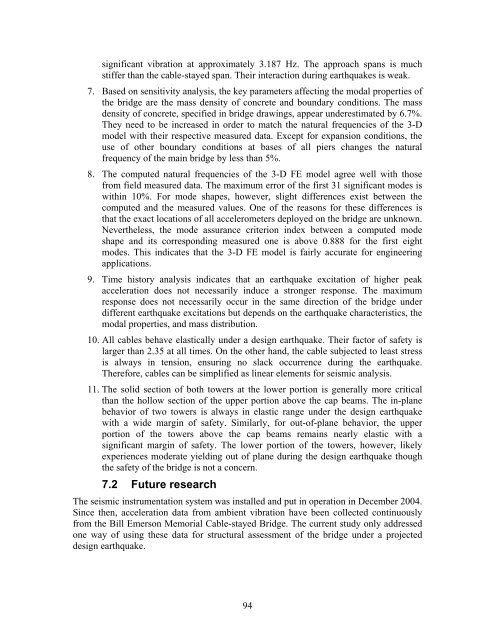Assessment of the Bill Emerson Memorial Bridge - FTP Directory ...
Assessment of the Bill Emerson Memorial Bridge - FTP Directory ...
Assessment of the Bill Emerson Memorial Bridge - FTP Directory ...
- No tags were found...
You also want an ePaper? Increase the reach of your titles
YUMPU automatically turns print PDFs into web optimized ePapers that Google loves.
significant vibration at approximately 3.187 Hz. The approach spans is muchstiffer than <strong>the</strong> cable-stayed span. Their interaction during earthquakes is weak.7. Based on sensitivity analysis, <strong>the</strong> key parameters affecting <strong>the</strong> modal properties <strong>of</strong><strong>the</strong> bridge are <strong>the</strong> mass density <strong>of</strong> concrete and boundary conditions. The massdensity <strong>of</strong> concrete, specified in bridge drawings, appear underestimated by 6.7%.They need to be increased in order to match <strong>the</strong> natural frequencies <strong>of</strong> <strong>the</strong> 3-Dmodel with <strong>the</strong>ir respective measured data. Except for expansion conditions, <strong>the</strong>use <strong>of</strong> o<strong>the</strong>r boundary conditions at bases <strong>of</strong> all piers changes <strong>the</strong> naturalfrequency <strong>of</strong> <strong>the</strong> main bridge by less than 5%.8. The computed natural frequencies <strong>of</strong> <strong>the</strong> 3-D FE model agree well with thosefrom field measured data. The maximum error <strong>of</strong> <strong>the</strong> first 31 significant modes iswithin 10%. For mode shapes, however, slight differences exist between <strong>the</strong>computed and <strong>the</strong> measured values. One <strong>of</strong> <strong>the</strong> reasons for <strong>the</strong>se differences isthat <strong>the</strong> exact locations <strong>of</strong> all accelerometers deployed on <strong>the</strong> bridge are unknown.Never<strong>the</strong>less, <strong>the</strong> mode assurance criterion index between a computed modeshape and its corresponding measured one is above 0.888 for <strong>the</strong> first eightmodes. This indicates that <strong>the</strong> 3-D FE model is fairly accurate for engineeringapplications.9. Time history analysis indicates that an earthquake excitation <strong>of</strong> higher peakacceleration does not necessarily induce a stronger response. The maximumresponse does not necessarily occur in <strong>the</strong> same direction <strong>of</strong> <strong>the</strong> bridge underdifferent earthquake excitations but depends on <strong>the</strong> earthquake characteristics, <strong>the</strong>modal properties, and mass distribution.10. All cables behave elastically under a design earthquake. Their factor <strong>of</strong> safety islarger than 2.35 at all times. On <strong>the</strong> o<strong>the</strong>r hand, <strong>the</strong> cable subjected to least stressis always in tension, ensuring no slack occurrence during <strong>the</strong> earthquake.Therefore, cables can be simplified as linear elements for seismic analysis.11. The solid section <strong>of</strong> both towers at <strong>the</strong> lower portion is generally more criticalthan <strong>the</strong> hollow section <strong>of</strong> <strong>the</strong> upper portion above <strong>the</strong> cap beams. The in-planebehavior <strong>of</strong> two towers is always in elastic range under <strong>the</strong> design earthquakewith a wide margin <strong>of</strong> safety. Similarly, for out-<strong>of</strong>-plane behavior, <strong>the</strong> upperportion <strong>of</strong> <strong>the</strong> towers above <strong>the</strong> cap beams remains nearly elastic with asignificant margin <strong>of</strong> safety. The lower portion <strong>of</strong> <strong>the</strong> towers, however, likelyexperiences moderate yielding out <strong>of</strong> plane during <strong>the</strong> design earthquake though<strong>the</strong> safety <strong>of</strong> <strong>the</strong> bridge is not a concern.7.2 Future researchThe seismic instrumentation system was installed and put in operation in December 2004.Since <strong>the</strong>n, acceleration data from ambient vibration have been collected continuouslyfrom <strong>the</strong> <strong>Bill</strong> <strong>Emerson</strong> <strong>Memorial</strong> Cable-stayed <strong>Bridge</strong>. The current study only addressedone way <strong>of</strong> using <strong>the</strong>se data for structural assessment <strong>of</strong> <strong>the</strong> bridge under a projecteddesign earthquake.94
















